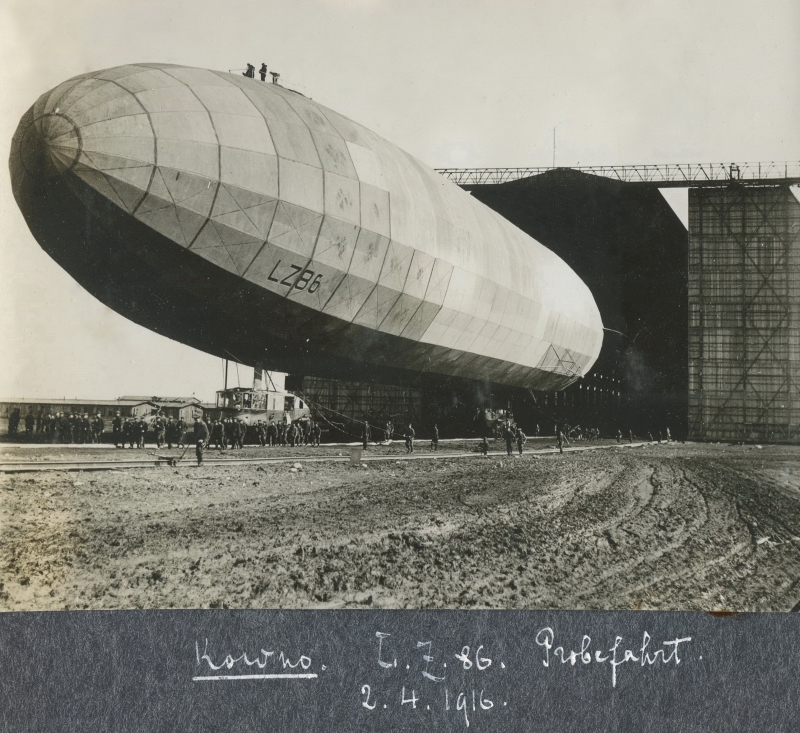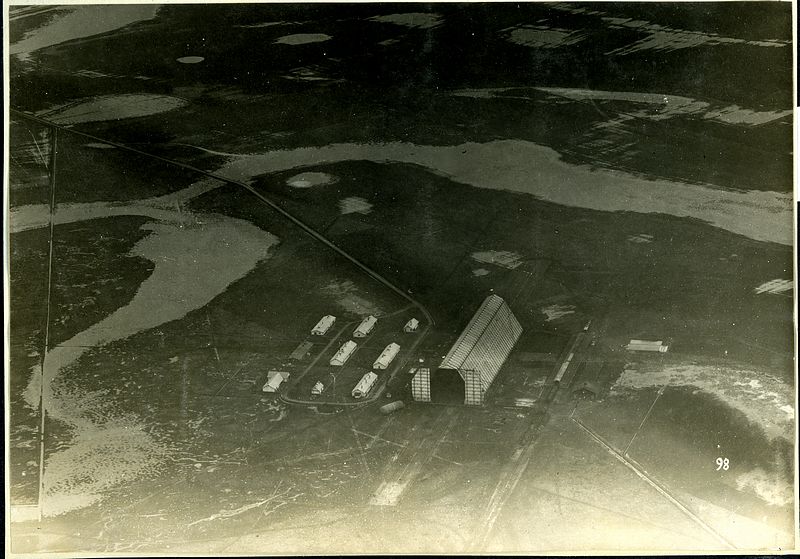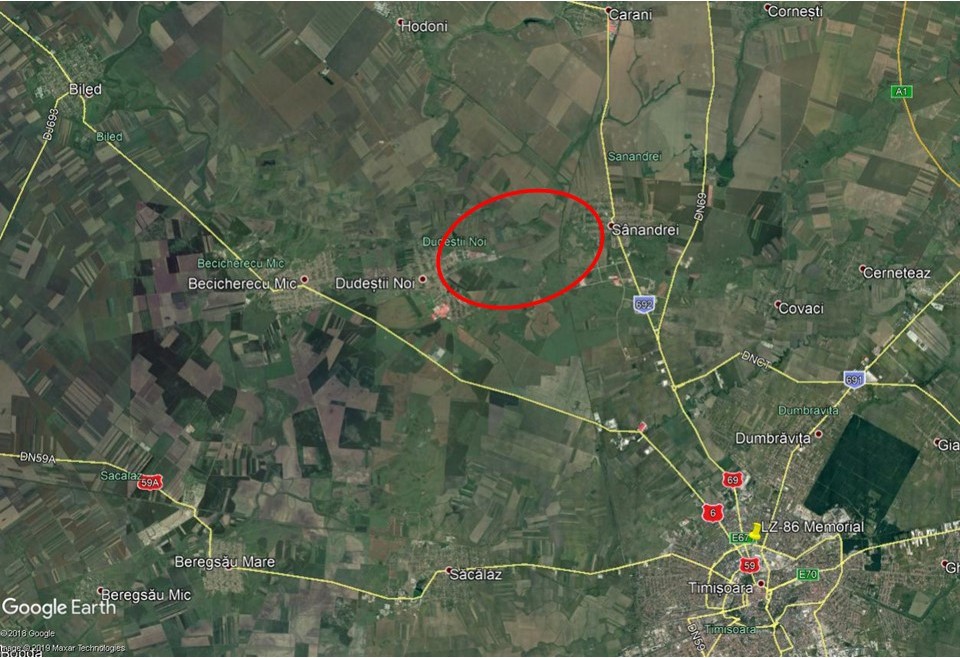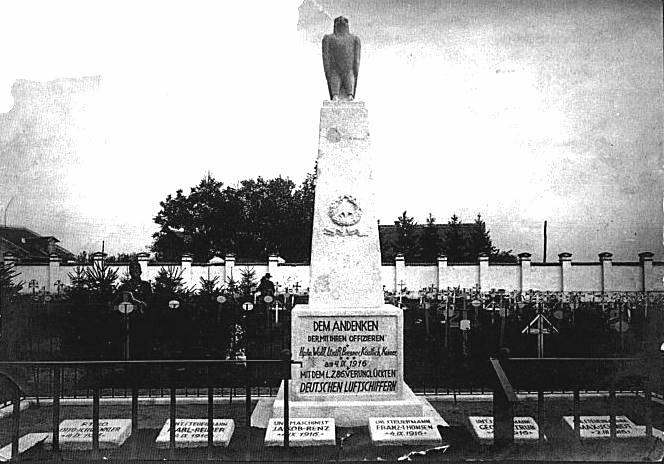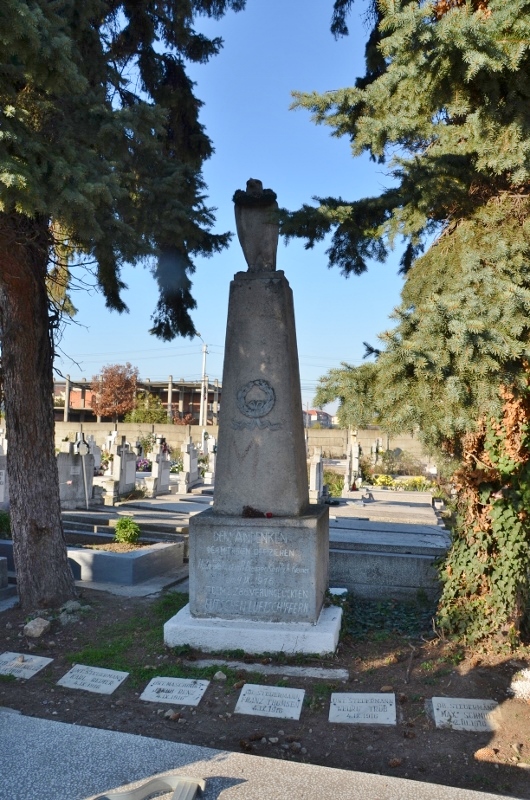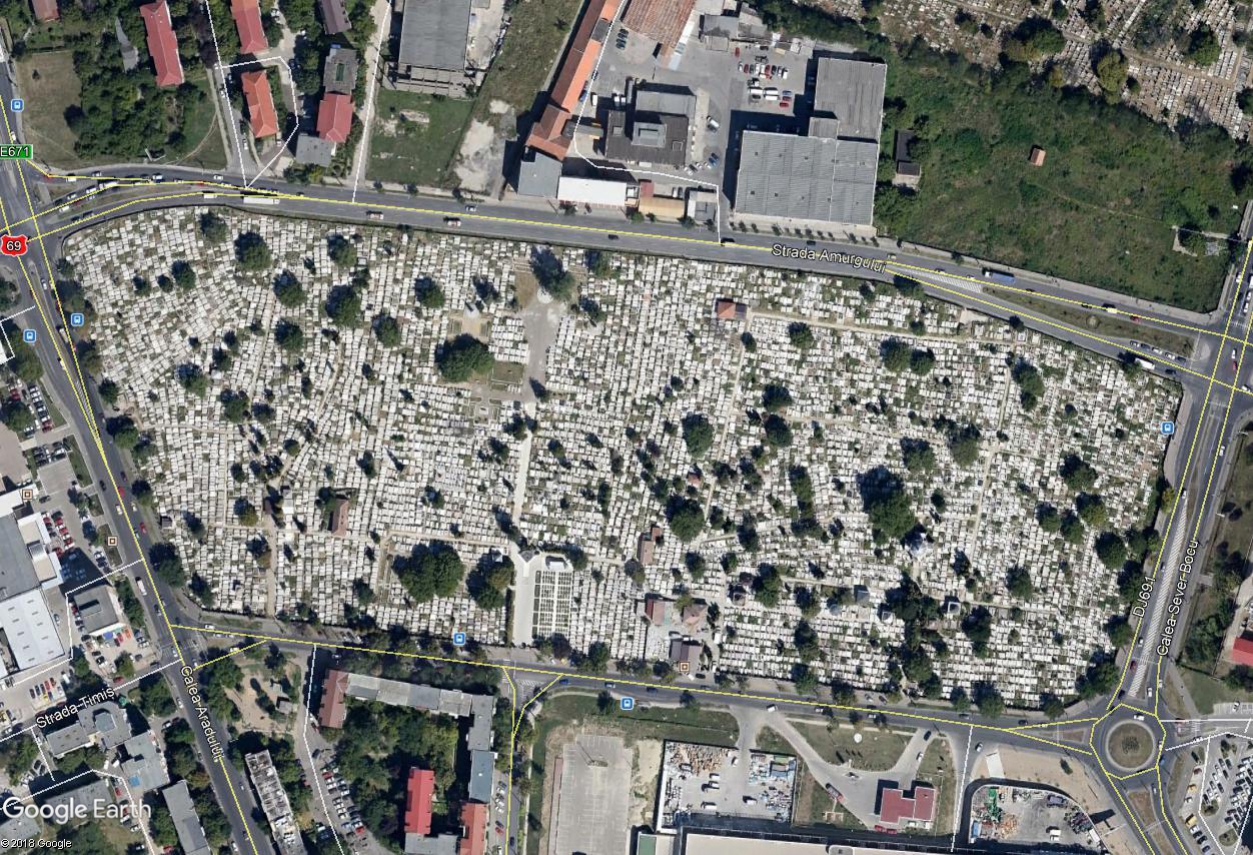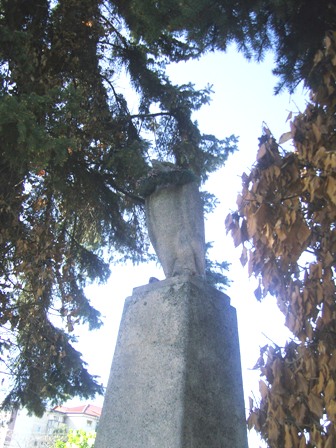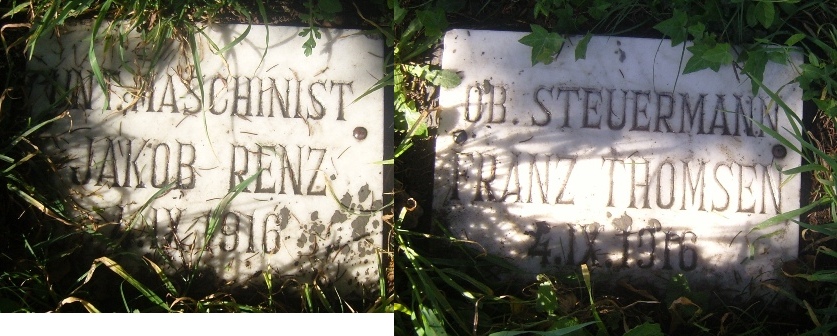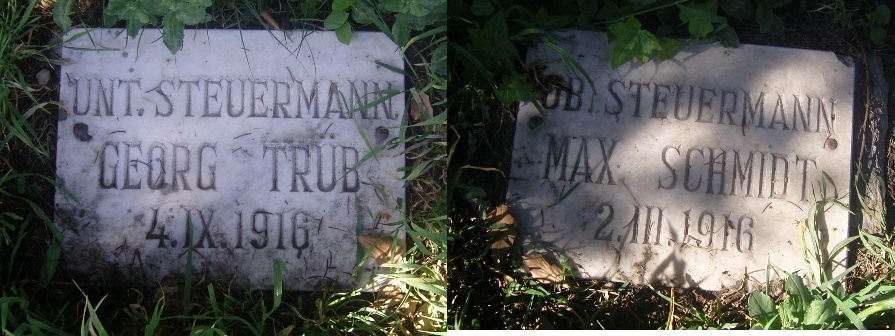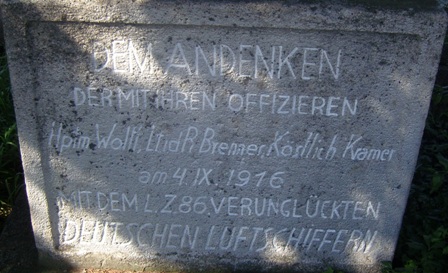There is a graveside monument in Timișoara, Romania dedicated to five of the nine men who died in the German LZ-86 which, upon returning from a raid on Bucharest and Ploesti ultimately crashed near her base somewhere near Dudestii Noi and Sânandrei, Romania on 4 Sep 1916. The Zeppelin base was only about 10 km NW of Timișoara, Romania.
Timișoara, Romania LZ-86 crew grave-site
Zeppelin LZ-86:
The German LZ-86 was the 56th German Zeppelin. (All Zeppelins procured by the German government for military service had "30" added to their production number.) The LZ-86 was built in October, 1915 at Löwental (NE Friedrichshafen) and originally stationed at Kowno*, occupied Lithuania. She was used in bombing runs on Dünaburg between late 1915 and February, 1916 and in April, 1916 was enlarged to a greater hydrogen volume "q" type Zeppelin. (Luftschiffhalle St. Andrew, Sinandrei, Neubeschenowa - Novi Sad - Dudestii Noi 3. (Hungarian).)
The LZ-86 emerging from the hangar at Kowno, occupied Lithuania, 2 April, 1916. Photo credit: Public domain, found at https://scharekf.hu/dotroll/besenyo3.htm
(* In the text and on the photo above, dated April 2, 1916, the LZ-86 is shown emerging from the airship hangar at "Kowno" in Luthuania. Kowno is the generally known name of the town before Lithuania regained independence. In English, you will also find "Kovno", the traditional Slavicized form of its name.)
In 1916, the LZ-86 now based out of Sânandrei (St. Andrews, Romania), Romania, carried out seven attacks on Eastern and Southern Europe, dropping a total of 14,800 kg of bombs.
I have not been able to positively identify the exact location of the German base and airship hangar near St. Andrews (Sânandrei), Romania, but here is a photo of the site circa 1916:
The airship hangar at St. Andrews, Romania. Photo credit: Public domain, found at http://scharekf.hu/dotroll/besenyo.html
Surviving literature indicates the airship and airfield at St. Andrews was located between Dudestii Noi and St. Andrews (Sânandrei), Romania at approximately (Lat Lon) 45.844232 021.129939. Here is a Google Maps image of the area:
Photo credit: Google Maps
The LZ-86 Disaster
The following is paraphrased from the Hungarian article: Luftschiffhalle St. Andrew, Sinandrei, Neubeschenowa - Novi Sad - Dudestii Noi 3.
On the night of September 3-4, 1916, from St. Andrews, the LZ-86 conducted bombing raids on oil refineries in Bucharest and Ploesti. She was spotted, illuminated by searchlights, and took heavy antiaircraft fire. During the return flight to St. Andrews, she lost a lot of hydrogen and was flying "heavy". She was not neutrally buoyant, so when the engines were cut for landing, the craft, now heavy lacking dynamic buoyancy, fell rapidly to the ground. Heavier at the stern, the rear of the airship impacted the ground, tearing loose the rear control car, and 3 engines.
Now, the stern of the airship is suddenly much lighter with the loss of enormous mass, and the LZ-86 rose back into the early morning sky. As the LZ-86 rose, the forward control car tore loose from its cables and fell to the ground. All in the forward end of the airship died either by jumping, trapped in the falling control car, or hit by the falling debris.
Now the airship was even lighter, and the entire envelope, minus its control cars and engines and most personnel rose uncontrolled into the sky. With 2-3 (?) crew left on the now helpless airship, they try to rupture hydrogen cells to release gas so the airship would descend.
The extant record indicates that the main body of the LZ-86 came down some 80 km from the St. Andrews airship base. Of the 14 crew, 9 perished and 5 survived. Five of the victims are buried at the "Tombs of Heroes" cemetery, Temesvár (Timisoara) Romania.
Timișoara, Romania LZ-86 crew grave-site:
This study began with this photo of the grave site:
Photo credit: Public domain, From the collection of Harry C. Redner, Germany
Its location remained a mystery to me for quite a while until I found the clues which led me to look at Temesvár (Timisoara) Romania. Here is an undated but fairly recent photo of the now 100+ year old monument to the crew of the LZ-86:
Photo credit: http://www.timisoarastiri.ro/dosare-secrete-zeppelinele-ucigase-de-la-timisoara-au-lovit-bucurestiul-ploiestiul-chisinaul-si-salonicul-2/
Where is this located? The 1st photo above, though undated, it appears to be from the era, that is, within a few years after its placement, thus possibly from the 1920s. Research quickly revealed that it is in Timișoara, Romania, in the "Tombs of the Heroes" cemetery. But upon locating the "Tombs of the Heroes" cemetery, here is what you find:
"Tombs of the Heroes" cemetery, Timișoara, Romania. Photo credit: Google Maps
Just where in this massive cemetery will the LZ-86 gravesite be found? To make a long story short, after attempting to locate the gravestone by the background wall seen in the original photo (which was a dead-end), I found a photo of the top portion of the pillar on which the eagle sits, which revealed a subtle clue!
LZ-86 pillar, "Tombs of the Heroes" cemetery, Timișoara, Romania. Photo credit: http://scharekf.hu/dotroll/besenyo3.htm
That clue is the red-roofed building just barely seen in the lower-left corner of the photo! I was able to match the features of that building with an existing building found in Google Maps! (Indeed, the roof is seen in the overview shot of the cemetery above.) Triangulating on that image, led me to isolate and approximate area for the LZ-86 gravesite, and then, using Google 360 images found within Google Earth, I spotted the monument's pillar, with the eagle on top, and was able to make a very good estimate of its precise location.
The grave-site monument to 5 of the 9 men who died in the crash of the LZ-86 is located at (Lat Lon) 45.769799 21.225915, at cemetery "Tombs of the Heroes", Timișoara, Romania. (Admittedly, I have not validated these coordinates, but am very confident that these coordinates are close enough that the monument will be easily found by these coordinates alone. These coordinates should be within 25-50 feet of the monument but I would be most grateful if a reader would visit the site and send me actual lat-lon coordinates!)
The exact location of the gravesite in Google Maps:
The 6 men buried here are: Jacob RENZ Jacob, Otto SCHIENKLER, Georg TRÜB, Franz THOMSEN, Karl REIMER, and Max SCHMIDT.
Photo credit: Undated photos of the 6 headstones of the LZ-86 gravesite. http://scharekf.hu/dotroll/besenyo3.htm
Curiously, the first 5 are known to have died in the LZ-86 accident on 4 September, 1916, but the 6th, Navigator Max Schmidt, is recorded to have died on the 2nd of March, 1916, (from his headstone). He died of traumatic pneumonia contracted after being injured in a hard landing of the LZ-85 at the conclusion of a raid on Thessalonica, 8-9 Feb, 1916. Herr Schmidt may have been a member of both airship crews. Though he was not a crew member when the LZ-85 went down on 5 May, 1916, in Thessalonica harbor (Greece) and it may be that his remains were already entombed at Timișoara, and he was subsequently entombed with his comrads. I refer you to the German article "Zeppeline über dem Balkan" in the March 2018 issue of Luftwaffen Revue, page 18.
The inscription on the monument. Photo credit: http://scharekf.hu/dotroll/besenyo3.htm
On one face of the LZ-86 memorial it reads:
To the memory of the German airshipmen,
who with their officers Commander Wolff,
Leutnants of the Reserve Brenner, Köstlich, Krämer,
perished in the LZ 86 accident on 4 September 1916.
[Note: Krämer appears misspelled on the memorial as "Kramer".]
Please refer to the excellent photo journal of the accident and the monument here (in Hungarian), about 1/3 of the way down the page: scharekf.hu/dotroll/besenyo3.htm.

